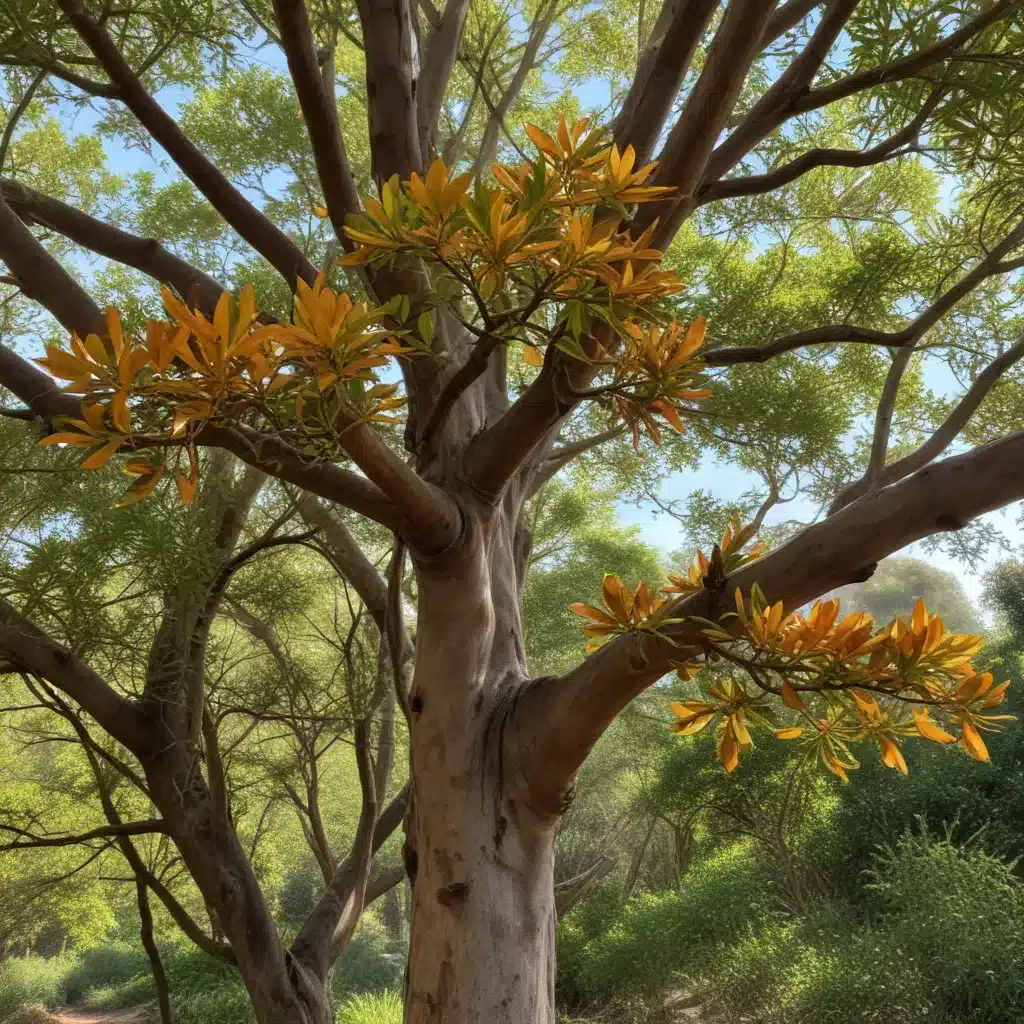
The Madrone (Arbutus menziesii), a captivating evergreen tree native to the Pacific Northwest, commands attention with its striking crimson bark, glossy green foliage, and clusters of delicate white flowers. This charismatic species, part of the Ericaceae family, thrives in the diverse ecosystems that stretch from British Columbia to central California, enchanting all who encounter it. As a tree care specialist for TriCounty Tree Care, I am delighted to delve into the marvels of this remarkable arboreal icon.
Madrone Tree Characteristics
The Madrone is a distinctive evergreen tree known for its captivating bark. As the tree matures, its smooth, reddish-brown bark exfoliates in thin, papery sheets, revealing a new layer of vibrant orange-red underneath. This peeling pattern creates a mesmerizing, almost otherworldly appearance, earning the Madrone the nickname “the chameleon of the forest.” The tree’s leathery, dark green leaves are elliptical in shape, with a glossy sheen that further enhances its visual appeal.
In the spring, the Madrone produces clusters of delicate, urn-shaped white flowers that resemble those of its botanical cousin, the Manzanita (Arctostaphylos). These blooms eventually give way to spherical, berry-like fruits that ripen to a deep, translucent red, providing a striking contrast to the tree’s foliage. The Madrone’s unique combination of distinctive bark, lustrous leaves, and captivating flowers and fruit make it a true standout in the landscape.
Madrone Tree Taxonomy
The Madrone belongs to the Ericaceae family, which includes a diverse array of woody, flowering plants such as rhododendrons, heathers, and blueberries. Within this family, the Madrone is classified under the genus Arbutus, which comprises approximately 20 species found across the Northern Hemisphere. The species name menziesii honors the Scottish botanist Archibald Menzies, who first collected and described the tree during his voyages along the Pacific coast in the late 18th century.
In addition to the Madrone, the Arbutus genus includes several other notable tree species, such as the Strawberry Tree (Arbutus unedo) native to the Mediterranean region and the Pacific Madrone (Arbutus × media), a natural hybrid between the Madrone and the Strawberry Tree. These related species share many of the Madrone’s distinctive characteristics, highlighting the genus’s remarkable diversity and adaptability.
Madrone Tree Habitat and Distribution
The Madrone is a true native of the Pacific Northwest, with its natural range spanning from British Columbia in Canada to central California in the United States. Within this region, the tree thrives in a variety of coastal and inland habitats, including mixed coniferous-deciduous forests, chaparral communities, and even rocky, exposed slopes.
The Madrone’s preference for well-drained, acidic soils and its tolerance for drought and fire make it a resilient species capable of adapting to diverse ecological niches. In its northernmost range, the tree may be found alongside towering Douglas Firs (Pseudotsuga menziesii) and Western Red Cedars (Thuja plicata), while in the south, it coexists with California Live Oaks (Quercus agrifolia) and Toyon (Heteromeles arbutifolia).
Interestingly, the Madrone’s distribution is not continuous, as the tree is often absent from certain areas within its native range. This patchiness is thought to be the result of a complex interplay between the species’ ecological requirements, historical climate fluctuations, and the impact of human activities, such as logging and land-use changes.
Madrone Tree Significance
The Madrone holds significant cultural and ecological importance throughout its native range. For many Indigenous communities, the tree has long been revered for its medicinal and utilitarian properties. The tree’s bark, leaves, and fruit have been used to treat a variety of ailments, from skin infections to respiratory issues, while the wood has been prized for its use in tool-making and the construction of traditional structures.
In addition to its cultural significance, the Madrone also plays a vital role in the region’s diverse ecosystems. Its nectar-rich flowers provide an important food source for pollinators, such as bees and hummingbirds, while its berries are eagerly consumed by a wide array of birds and small mammals. The tree’s dense foliage also offers valuable shelter and nesting sites for numerous species of wildlife.
Beyond its ecological and cultural value, the Madrone has long been celebrated for its ornamental appeal. The tree’s striking bark, glossy leaves, and delicate flowers make it a popular choice for landscaping and garden design, particularly in areas where its native range overlaps with human settlements. TriCounty Tree Care is proud to assist homeowners and landowners in incorporating this charismatic species into their outdoor spaces, helping to preserve the Madrone’s unique legacy.
Madrone Tree Challenges
Despite its many remarkable qualities, the Madrone faces a number of challenges that threaten its long-term survival. One of the primary threats to the tree is the ongoing impact of human activities, such as land development, logging, and the introduction of invasive species. These pressures can disrupt the delicate balance of the Madrone’s native habitats, leading to declining populations and increased vulnerability to pests and diseases.
Furthermore, the Madrone’s susceptibility to certain fungal pathogens, such as the Anthracnose (Discula umbrinella) and the Sudden Oak Death (Phytophthora ramorum) diseases, pose significant challenges for the species’ conservation. These diseases can weaken the tree’s defenses, leading to dieback, canker formation, and even complete mortality in severe cases.
In response to these threats, various conservation efforts have been undertaken to protect the Madrone and ensure its continued presence in the Pacific Northwest. These initiatives often involve strategies such as habitat restoration, targeted disease management, and public education campaigns to raise awareness of the tree’s ecological and cultural significance. TriCounty Tree Care is proud to contribute to these efforts, working closely with local authorities and community organizations to safeguard the Madrone for future generations.
Despite the challenges it faces, the Madrone remains a captivating and resilient species, commanding the admiration of all who encounter it. As a tree care specialist, I am honored to share the marvels of this charismatic evergreen, and I encourage everyone to explore the wonders of the Madrone and support its preservation in the Pacific Northwest.


